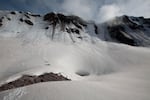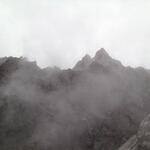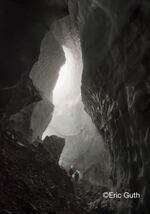Producer: Ed Jahn, Videographer/Editor: Todd Sonflieth, Audio: Steven Vaughn Kray, Special Thanks: JL Aviation, Additional Video: Craig McClure, Brent McGregor, USGS/Cascade Volcano Observatory
One minute we were walking out to a helipad in Boring, Oregon. Thirty minutes later, we were standing on a black, steaming fist of magma in the center of Mount St. Helens’ city-sized crater. Photographer Todd Sonflieth and I barely had time to grab our camera gear before we witnessed skull-crushing rocks peeling off the rim, avalanches cascading down the cliffs, steam and volcanic gases burping out of cracks in the rocks. And to think that Eddy Cartaya had to plead with officials for permission to be here.
"The impression we got back is that they almost think we’re crazy to want to go out there and do this,” Cartaya said.
What Cartaya wanted to do was launch an expedition to a cave system rumored to exist inside the glacier on the crater’s south side. He wanted to be first.
“We’re going where no one has ever been,” he said, “before today.”

The expedition prepares to descend into "Godzilla Hole" below the crater rim.
Todd Sonflieth / OPB
Jared Smith first spotted the caves on a climbing trip he was leading for the Mount St. Helens Institute.
“I’ve been looking at these holes for years from the rim,” he said. “I just always wanted to come down and check em’ out.”
Smith told Cartaya and his caving partner, Brent McGregor, what he’d seen, and together the team began organizing an expedition that they estimated would take five days and a crew of about a dozen. We would be the eyes and ears for the public, since the public is otherwise forbidden to enter the crater.
A few months later, permits in hand, we were setting up tents in the rain in a crater that had all the cozy comfort of Tolkien's Mordor.
And that was before the storm hit.

Mordor? Or Mount St. Helens?
Ed Jahn / OPB
To say the expedition to the caves was overshadowed by the weather wouldn’t quite be true. Over the first few days, Cartaya’s team managed to map and explore two massive cave systems, including the so-called “Godzilla Hole” with its 80-foot-high ceiling.
The caves were spectacular. Inside them, seedlings grew in darkness. Odd mineral formations coated the warm, volcanic rocks. Vapors gave the caverns an otherworldly feel. And the caves proved far more extensive than Cartaya expected, too. He estimated his team explored less than 20 percent of the passages inside the crater.

Neil Marchington lowers into the Godzilla Hole.
Eric Guth / Eric Guth Photography
But for all the success of the mission to explore the caves, the weather soured things fast. For days we'd successfully dodged rockfall and avalanches with a smile. But 40 mph winds and sideways sleet for two days has a way of shutting things down in a hurry.
The helicopter never came back to get us. On the fifth day we were faced with a choice: hunker down for several more days and weather another approaching storm or leave.
We left.

Hot vapors rising from the floor of the volcano likely had a hand in sculpting the passages found in the Mount Saint Helens glacier cave system.
Eric Guth / Eric Guth Photography
Circumstances forced us to leave all of our gear and our video from this story back in the crater. We grabbed only the food and water and clothing we needed and beat feet with the rest of the team on a blister-inducing trek across a glacier and out of the crater over the course of eight tense hours. We'd love to say we documented it all on camera, but with an ice axe clutched tightly in one hand, a trekking pole in the other, and no free hands to operate the one GoPro we had with us, it just didn't happen.
The happy ending to our tale of weather woes? Three days after we made it back safely to town, I got a call from the helicopter pilot. He'd made it back to the crater and retrieved all of our gear. And our video.
Now go enjoy the show from the comfort of someplace warm and dry!
MORE INFORMATION
Cascade Volcano Observatory
